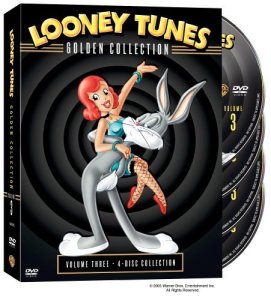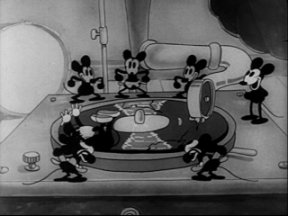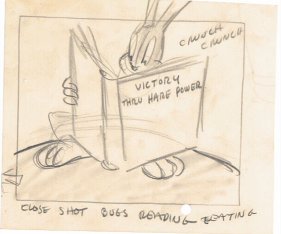Looney
Tunes:
Golden Collection v.3
A stern warning
appears in small print on the back cover. "Looney Tunes
Golden Collection Volume 3 is intended for the adult collector
and may not be suitable for children." Considering that
the men at Termite Terrace made these shorts to amuse adults
in the first place, that may not be so off-base.
But in the years
since Warner Brothers' heyday of the 40s and 50s, children
saw these cartoons in endless reruns and took them to heart.
As Chuck Jones comments in an included documentary, the
result, of course, was the raising of a nation of psychopaths.
For the best
of the Looney Tunes are ridiculously subversive. They're
also ridiculously fun. This third DVD collection from Warner
Brothers' comprehensive attempt to preserve them all has
a lot of the fun stuff. The parts for the adult collector
may not be so much unsuitable as perplexing for children.
Each disc begins
with a cautionary message from Whoopi Goldberg, trying to
put the cartoons in an historical context. Political correctness
never did sit well with the Looney Tunes, and Goldberg's
message is important. Particularly in the oldest cartoons
in the collection, casual racism sweeps by almost as fast
as …well, Speedy Gonzalez, a character that troubles some.
That's history,
and Warner Brothers has wisely chosen not to cover it up.
Some of the most historical and possibly offensive cartoons
have been placed separately in each disc, requiring some
hunting on the menu, as being "From the Vault." These include
a series of "Private Snafu" shorts, wartime efforts featuring
all kinds of stereotyping that was perfectly acceptable
toward the enemy.
Also include
in the Vault are the very earliest cartoons, set apart for
being simply too nonsensical, plotless and looking too much
like just about every other cartoon from 1930. In a new
mini-documentary, experts agree that early characters like
Bosko and Buddy had no real personality, nor did Warner
Brothers see these cartoons as anything other than a way
to sell sheet music (hence "Merry Melodies" and "Looney
Tunes"). The fact that they look almost identical to what
Disney was doing is acknowledged, but to be fair, everybody
was doing it that way.
When characters
like Porky appeared, then the evolution began. All four
discs do a good job of tracing that development without
sacrificing entertainment. Apparently, so have the earlier
collections, yet every major character manages to make a
prototypical appearance here.
Bugs Bunny and
Porky Pig make the lions' share of appearances, though Daffy
Duck cameos in several of their cartoons. In truth, he makes
a better foil for them than a solo character, and some of
all of their best shorts are here.
For genre fans,
the collection includes "Super-Rabbit" and "Snafuperman,"
which begs the question as to why Warner Brothers hasn't
taken those public domain Fleischer Superman shorts and
given them the same beautiful treatment these Looney Tunes
have gotten.
And it is beautiful
treatment. Mini-documentaries go far to explaining the exhaustive
restoration process, and also possibly answered my own question
in going over this set: what's the rhyme or reason to these
releases?
It may just
be that they gather them up and release them as they finish
restoration on a block. The first disc celebrates the so-called
"Wabbit Season Trilogy" in a feature that includes comments
from Paul Dini and Billy West (sometime voice of Bugs).
But only one episode of the trilogy makes it onto the disc,
"Duck, Rabbit! Duck!"
Maybe the gold
is better spread out across collections, so you don't quite
notice the gags that repeat. These were, after all, made
at a time when nobody could envision these masterpieces
being seen over and over again. They were, as Goldberg intones,
of their time and made for their time.
That comes apparent
in the second disc, "Hollywood Caricatures and Parodies."
While "The Honey-Mousers" still strikes a chord thanks to
endless reruns of its source material and The Flintstones,
"The Mouse That Jack Built" may leave kids wondering who
the actual human is at the end of the short. The earliest
films on the disc still have gags that work, but they also
clearly reference Hollywood stars that have faded from public
consciousness. I think Ronald Colman makes a couple of appearances,
but mentioning that may have utterly lost you.
To bring it
back, and this one goes for the kids, the extras feature
a lot of love letters to the men of Termite Terrace. Of
course, Chuck Jones has been feted over and over, but a
BBC documentary from 1989 does a really good job of showing
the man at work. Hearing his philosophizing on animation
is comforting and inspiring, and if you have any kids interested
in animation as an art form, they need to watch this.
(A nice companion
piece for the kids is a Warner-approved book from Chronicle
released a couple of months ago. Draw the Looney Tunes: The Warner Bros. Character Design Manual , though
featuring many, many WB characters, is actually specifically
about how to draw Bugs Bunny, but a sharp budding artist
will take the lessons and apply them to other characters.
It's a thoroughly illustrated text that really delineates
all the elements of good cartoon design - here endeth an
overdue side plug for a must-have book.) , though
featuring many, many WB characters, is actually specifically
about how to draw Bugs Bunny, but a sharp budding artist
will take the lessons and apply them to other characters.
It's a thoroughly illustrated text that really delineates
all the elements of good cartoon design - here endeth an
overdue side plug for a must-have book.)
Jones isn't
the only animator given the spotlight, and rightfully so.
The set also includes a documentary on the underrated Frank
Tashlin, who shepherded Porky Pig to stardom. All throughout
the extras, however, historians and Jones himself gives
credit to many unsung heroes of the Looney Tunes, such as
layout designer Maurice Noble.
The team also
gets acknowledged even after they left Warner Brothers for
a while. (That crafty conglomerate has managed to get the
rights to a lot of their other work.) In a Vault on Disc
Three, "The Bear That Wasn't" is a Looney Tune that isn't,
because it was actually done at MGM.
Of further historical
Fanboy interest, Disc Four has a failed television pilot,
Philbert, a sitcom mixing live-action with one lone
animated cartoon character. Check the genealogy: animation
by Friz Freleng (who later gave us the Pink Panther) but
actually directed by a young upstart named Richard Donner.
Yes, the same Richard Donner who directed Superman
and hopefully a restored Superman II, who later mentored
Geoff Johns and gave his blessing to Bryan Singer for Superman
Returns. Thankfully, these falling dominoes are entertaining.
In
the end, though, the collection stands or falls on the cartoons,
and each disc has at least a handful that will bring back
fond memories of your childhood. Which is kind of weird;
it's always disconcerting to realize that your childhood
was meant for adults.
Looney Tunes - Golden Collection, Volume Three
Looney Tunes - Golden Collection, Volume Two
Looney Tunes - Golden Collection
|










